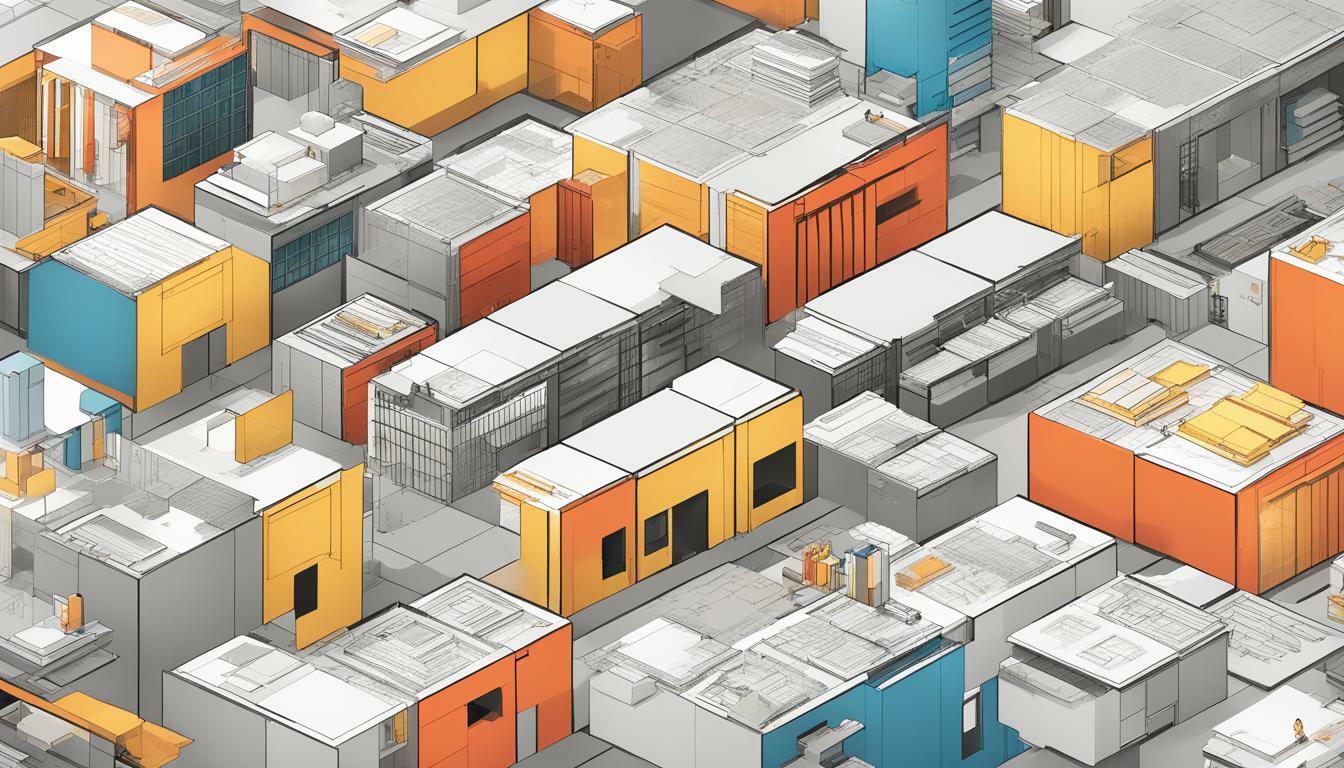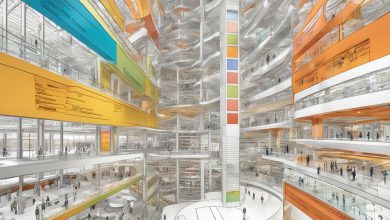
As software architecture continues to evolve, stateless and stateful architecture have emerged as two popular models. While both approaches have their merits, understanding their differences, benefits, and characteristics is pivotal in determining which solution is right for your business needs.
Stateless architecture is a model where the server does not maintain any state information about the client session. In contrast, stateful architecture maintains the client’s session and context information on the server. The difference between these two models lies in the way they handle state management and data persistence.
Stateless architecture is highly scalable as it does not maintain any client information, making it easier to deploy, maintain, and troubleshoot. On the other hand, stateful architecture supports fault-tolerant scenarios and maintains context information, allowing it to handle complex business logic.
Key Takeaways:
- Stateless and stateful architecture are two popular software models.
- Stateless architecture does not maintain any state information about the client session, while stateful architecture does.
- The difference between these models lies in the way they handle state management and data persistence.
- Stateless architecture is highly scalable, while stateful architecture is fault-tolerant.
What is Stateless Architecture?
Stateless architecture is a software development approach that does not require the system to store any data or state information between transactions or user requests. Instead, each request is processed independently, with no reference to the previous state of the system.
A key characteristic of stateless architecture is that it does not have any mechanism to manage and store session or state information, which can lead to improved performance and scalability.
Stateless architecture relies on the client to pass all necessary information with each request, making the system more lightweight and scalable compared to stateful architecture, where the server has to maintain states and contexts for each client separately.
In stateless architecture, each request is self-contained, and the server processes them independently and identically. This approach makes stateless architecture highly scalable, as new instances can be added to the system without worrying about state persistence or data replication.
In summary, the primary characteristics of stateless architecture include:
- No data or state information stored between transactions or requests
- Each request is processed independently and identically
- No mechanism for managing session or state information
- Reliance on the client to pass all necessary information with each request
- Improved scalability due to the lack of state management overhead
Advantages of Stateless Architecture
Stateless architecture has several advantages that make it a popular choice for many applications. Some of the key benefits include:
- Improved performance: Stateless architectures are designed to handle a large number of requests simultaneously, without the need to maintain session state information. This can lead to faster response times and better performance overall.
- Simplified deployments: Stateless architectures are easier to deploy and maintain, since there is no need to manage complex session state information across multiple servers or instances. This can save time and resources, and reduce the risk of errors or downtime.
- Better scalability: Stateless architectures can scale more easily than stateful alternatives, since they do not require expensive session state management or data persistence. This makes it easier to add or remove resources as needed, and ensures that the application remains responsive under heavy load.
Overall, the advantages of stateless architecture make it an attractive choice for many developers and businesses. By simplifying deployments, improving performance, and enabling better scalability, stateless architectures can help to streamline operations and deliver a more efficient, responsive application.
What is Stateful Architecture?
Stateful architecture, on the other hand, requires the server to maintain the state of each client session. This means that all the information related to a client’s activity and history is stored and managed by the server throughout the session. The server has to retrieve this data every time it receives a request from the client to ensure that the session remains consistent.
The characteristics of stateful architecture include:
- State management: The server is responsible for managing the state of each client session and retrieving the necessary data to maintain consistency.
- Data persistence: All the information related to a client’s activity and history is stored and managed by the server throughout the session.
Data persistence is a critical aspect of stateful architecture, as it ensures that the server can maintain the consistency of the session even if the client loses connection or experiences an error. This can be particularly important in scenarios where users are performing complex tasks and need to keep track of their progress.
Advantages of Stateful Architecture
Stateful architecture has several advantages over stateless architecture, particularly in scenarios where maintaining context and handling fault-tolerance are critical. Let’s take a closer look at the benefits of stateful architecture:
- Fault-tolerance: One of the major advantages of stateful architecture is its ability to handle fault-tolerance scenarios. In stateful systems, data is stored and persisted, making it easier to pick up where the system left off in case of an outage or failure.
- Easy session management: Since stateful systems maintain context, it is easier to manage sessions in these systems. Session management involves the ability to maintain user-specific data across multiple requests, which is essential for several web applications.
- Higher scalability: While stateless architecture is known for its scalability benefits, stateful architecture can also scale quite well. With stateful systems, the server retains context, allowing it to minimize the overhead associated with exchanging session-specific information between the client and server.
- Improved performance: Stateful systems tend to have better performance when it comes to read operations. Since the data is stored locally on the server, it can be fetched much faster than if it were stored remotely.
- Simplified code: Code written using stateful architecture tends to be simpler than stateless code because it does not need to manage state explicitly.
Overall, stateful architecture is a great choice when it comes to handling complex web applications that require session management, fault-tolerance, and better performance. However, it may not be suitable for some applications that require high levels of scalability.
Stateless vs. Stateful Architecture: A Comparison
Both stateless and stateful architecture have their unique characteristics and benefits. Here is a comparison between the two:
| Characteristics | Stateless Architecture | Stateful Architecture |
|---|---|---|
| State Management | Stateless architecture does not store any client context on the server between requests. Each request is self-contained and can be processed independently. | Stateful architecture retains client context on the server between requests. This allows the server to maintain state and respond to requests with relevant context. |
| Data Persistence | Stateless architecture does not require data persistence as there is no context to persist between requests. | Stateful architecture often requires data persistence to maintain client context on the server. |
| Scalability | Stateless architecture is highly scalable as requests can be processed independently without requiring any context from previous requests. | Stateful architecture can be harder to scale as client context needs to be maintained between requests, which can create resource constraints. |
Overall, stateless architecture is simpler and easier to deploy, with improved performance and scalability. Stateful architecture, on the other hand, is better suited for applications that require context to be maintained between requests and can handle fault-tolerance scenarios.
Ultimately, the choice between stateless and stateful architecture depends on the specific use case and the needs of the application. Understanding the characteristics and benefits of each approach can help make an informed decision.
Use Cases for Stateless Architecture
Stateless architecture is ideal for use cases where session management is not required. Since stateless architectures do not maintain session state, they are perfect for handling requests that do not require a specific user context. Stateless architectures can be used in a wide range of scenarios, particularly those that require high performance, availability, and scalability.
One of the most common use cases for stateless architecture is APIs, where the client sends a request to the server, and the server sends a response back without maintaining any session context. Stateless architectures are also commonly used in microservices-based applications, where services need to communicate with each other quickly and efficiently.
Stateless architectures are also beneficial in scenarios where a high volume of requests need to be processed simultaneously. For example, a stateless architecture can be used to handle website traffic during a sale or promotional event. Since the stateless architecture does not maintain user session context, requests can be processed quickly and efficiently, ensuring a smooth experience for all users.
In summary, stateless architecture is ideal for scenarios where session management is not required, and high performance, availability, and scalability are essential.
Use Cases for Stateful Architecture
Stateful architecture is particularly suited to scenarios where session management is necessary. Here are some of the common use cases for stateful architecture:
- Banking applications: Applications that require user authentication and session management, such as online banking, often utilize stateful architecture to maintain the user’s session information throughout the application.
- E-commerce websites: Online shopping carts and user account information require the use of session management, making stateful architecture a good choice for e-commerce websites.
- Real-time applications: Applications that require real-time data transfer, such as chat apps or multiplayer games, often require the use of stateful architecture to maintain the connections between users.
By utilizing stateful architecture in these use cases, developers can ensure that user data and context are maintained throughout the application, allowing for a smoother user experience.
Scalability Considerations in Stateless and Stateful Architecture
Scalability is a crucial factor to consider when choosing between stateless and stateful architecture. While both approaches have their benefits, their impact on performance and resource utilization can differ depending on the scalability requirements of the application.
Stateless Architecture:
Stateless architecture is highly scalable, as it does not require the management of session state or data persistence. This means that it can easily handle an increase in traffic by adding more servers to the system without worrying about synchronization issues or shared state. Stateless architecture can also benefit from load balancing techniques, which distribute traffic across multiple servers to improve overall performance.
Stateful Architecture:
Stateful architecture can also be scalable, but it requires careful consideration of data persistence and session management. When scaling up a stateful application, it is important to ensure that the state is synchronized across all instances of the application to prevent data inconsistencies. This can be achieved through techniques such as database replication or messaging middleware. Additionally, stateful applications can benefit from fault-tolerance mechanisms, such as clustering or failover, to ensure uninterrupted service even in the event of hardware or software failures.
Overall, the scalability considerations of stateless and stateful architecture depend on the specific requirements and constraints of the application in question. Both approaches have their strengths and weaknesses when it comes to scalability, and it is important to carefully evaluate these factors before making a decision.
Conclusion
In conclusion, the debate between stateless and stateful architecture ultimately depends on the specific needs and requirements of the application.
Stateless architecture offers benefits such as improved performance, simplified deployments, and easier scalability. It is best suited for applications where session management is not required, such as APIs, microservices, and web applications with a high volume of traffic.
On the other hand, stateful architecture provides the ability to maintain context and handle fault-tolerance scenarios. It is better suited for applications where session management is necessary, such as e-commerce sites, banking apps, and gaming apps.
When it comes to scalability, both approaches have their considerations. Stateless architecture is easier to scale horizontally due to the lack of state, while stateful architecture requires vertical scaling to handle increased data persistence requirements.
Ultimately, the choice between stateless and stateful architecture depends on a variety of factors, including performance needs, data persistence requirements, fault-tolerance scenarios, and session management needs. As always, it’s important to carefully evaluate the specific needs of your application before deciding on an architecture approach.
FAQ
Q: What is the difference between stateless and stateful architecture?
A: Stateless architecture manages state externally, while stateful architecture stores and manages state internally.
Q: What are the benefits of stateless architecture?
A: Stateless architecture offers improved performance and simplified deployments.
Q: How does stateless architecture handle state management?
A: Stateless architecture manages state externally, typically through the use of tokens or identifiers.
Q: What are the advantages of stateful architecture?
A: Stateful architecture can maintain context and handle fault-tolerance scenarios.
Q: How does stateful architecture handle state management?
A: Stateful architecture stores and manages state internally, typically in a database or memory.
Q: How does stateful architecture ensure data persistence?
A: Stateful architecture stores data internally, ensuring that it persists even in unexpected scenarios.
Q: What are the key differences between stateless and stateful architecture?
A: Stateless architecture manages state externally and is more scalable, while stateful architecture stores and manages state internally and is better suited for scenarios that require session management.
Q: What are the optimal use cases for stateless architecture?
A: Stateless architecture is best suited for scenarios where session management is not required.
Q: What are the optimal use cases for stateful architecture?
A: Stateful architecture is more suitable for scenarios that require session management, such as e-commerce platforms or applications with user authentication.
Q: What are the scalability considerations in stateless and stateful architecture?
A: Stateless architecture is more scalable as it does not rely on internal state storage, while stateful architecture may require additional resources to handle increased scalability demands.








